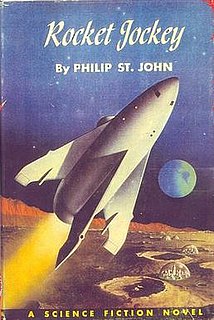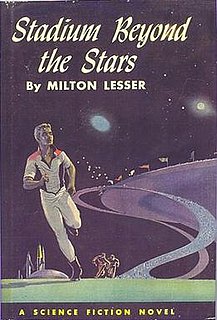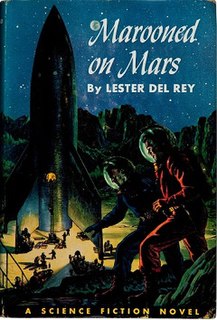
Galaxy Science Fiction was an American digest-size science fiction magazine, published from 1950 to 1980. It was founded by a French-Italian company, World Editions, which was looking to break into the American market. World Editions hired as editor H. L. Gold, who rapidly made Galaxy the leading science fiction magazine of its time, focusing on stories about social issues rather than technology.

Lester del Rey was an American science fiction author and editor. He was the author of many books in the juvenile Winston Science Fiction series, and the editor at Del Rey Books, the fantasy and science fiction imprint of Ballantine Books, along with his fourth wife Judy-Lynn del Rey.

Ace Books is a publisher of science fiction and fantasy books founded in New York City in 1952 by Aaron A. Wyn. It began as a genre publisher of mysteries and westerns, and soon branched out into other genres, publishing its first science fiction (SF) title in 1953. This was successful, and science fiction titles outnumbered both mysteries and westerns within a few years. Other genres also made an appearance, including nonfiction, gothic novels, media tie-in novelizations, and romances. Ace became known for the tête-bêche binding format used for many of its early books, although it did not originate the format. Most of the early titles were published in this "Ace Double" format, and Ace continued to issue books in varied genres, bound tête-bêche, until 1973.

Paul Warren Fairman (1909–1977) was an editor and writer in a variety of genres under his own name and under pseudonyms. His detective story "Late Rain" was published in the February 1947 issue of Mammoth Detective. He published his story "No Teeth for the Tiger" in the February 1950 issue of Amazing Stories. Two years later, he was the founding editor of If, but only edited four issues. In 1955, he became the editor of Amazing Stories and Fantastic. He held that dual position until 1958. His science fiction short stories "Deadly City" and "The Cosmic Frame" were made into motion pictures.

Startling Stories was an American pulp science fiction magazine, published from 1939 to 1955 by publisher Ned Pines' Standard Magazines. It was initially edited by Mort Weisinger, who was also the editor of Thrilling Wonder Stories, Standard's other science fiction title. Startling ran a lead novel in every issue; the first was The Black Flame by Stanley G. Weinbaum. When Standard Magazines acquired Thrilling Wonder in 1936, it also gained the rights to stories published in that magazine's predecessor, Wonder Stories, and selections from this early material were reprinted in Startling as "Hall of Fame" stories. Under Weisinger the magazine focused on younger readers and, when Weisinger was replaced by Oscar J. Friend in 1941, the magazine became even more juvenile in focus, with clichéd cover art and letters answered by a "Sergeant Saturn". Friend was replaced by Sam Merwin Jr. in 1945, and Merwin was able to improve the quality of the fiction substantially, publishing Arthur C. Clarke's Against the Fall of Night, and several other well-received stories.

Alexander A. Schomburg, born Alejandro Schomburg y Rosa, was a Puerto Rican commercial artist and comic-book artist and painter whose career lasted over 70 years in the mainland United States.

Attack From Atlantis (1953) is a science fiction novel written by Lester del Rey. The story follows the new U.S.S. Triton submarine on her maiden voyage, but trouble happens when the crew comes face to face with the inhabitants of the underwater city Atlantis.

Space Science Fiction was a science fiction magazine published by Space Publications, Inc. of New York and The Archer Press Ltd. of London that ran for eight issues from May 1952 to September 1953. Space was edited by Lester del Rey and featured a book review column by George O. Smith. Del Rey's conflicts with the publishers ensured that the magazine would have a short run, in spite of the superior quality of the stories. Illustrator Alex Ebel contributed to this magazine over the course of his career.
Milford "Mel" Joseph Hunter was a 20th-century American illustrator. He enjoyed a successful career as a science fiction illustrator, producing illustrations for famous science fiction authors such as Isaac Asimov and Robert A. Heinlein, as well as a technical and scientific illustrator for clients such as The Pentagon, Hayden Planetarium, and the Massachusetts Audubon Society.

Fantastic Universe was a U.S. science fiction magazine which began publishing in the 1950s. It ran for 69 issues, from June 1953 to March 1960, under two different publishers. It was part of the explosion of science fiction magazine publishing in the 1950s in the United States, and was moderately successful, outlasting almost all of its competitors. The main editors were Leo Margulies (1954–1956) and Hans Stefan Santesson (1956–1960); under Santesson's tenure the quality declined somewhat, and the magazine became known for printing much UFO-related material. A collection of stories from the magazine, edited by Santesson, appeared in 1960 from Prentice-Hall, titled The Fantastic Universe Omnibus.

Moon of Mutiny is a juvenile Science fiction novel by author Lester del Rey published in 1961 by Holt, Rinehart & Winston as the final part of the Jim Stanley Series. The story takes place mostly on the Moon following the adventures of the main character Fred Halpern after he is expelled from Goddard Space Academy for insubordination, and tries to find his way back into space.

Missing Men of Saturn is a juvenile science fiction novel, published first in 1953, by astronomer and author Robert S. Richardson with cover illustration by Alex Schomburg. The story concerns Dale Sutton's mission to the dreaded planet Saturn from which no one has ever returned. Missing Men of Saturn is a part of the Winston Science Fiction set, a series of juvenile novels which have become famous for their influence on young science fiction readers and their exceptional cover illustrations by award-winning artists.

Rocket Jockey is a juvenile science fiction novel by Philip St. John with cover illustration by Alex Schomburg. The story follows the heroic efforts of young man Jerry Blaine in his efforts to win the famous rocket race, the Armstrong Classic. Rocket Jockey is a part of the Winston Science Fiction set, a series of juvenile novels which have become famous for their influence on young science fiction readers and their exceptional cover illustrations by award-winning artists.

Stadium Beyond the Stars is a juvenile science fiction novel by Milton Lesser published in 1960 by Holt, Rinehart & Winston with cover illustration by Mel Hunter. The story follows the adventures of Steve Frazer, a champion spacesuit racer on Earth's Olympic team, as the ship taking him and the rest of the team to the center of the galaxy for the Interstellar Olympic Games intercepts a mysterious derelict spaceship. Stadium Beyond the Stars is a part of the Winston Science Fiction set, a series of juvenile novels which have become famous for their influence on young science fiction readers and their exceptional cover illustrations by award winning artists.

Rocket to Luna is a juvenile science fiction novel by prolific author and screenwriter Evan Hunter published in 1953 by The John C. Winston Company with cover illustration by Alex Schomburg. The story follows the adventures of the main character Ted Baker after he mistakenly replaces a member of the first lunar expedition at the last moment before the rocket leaves for the Moon. Rocket to Luna is a part of the Winston Science Fiction set, a series of juvenile novels which have become famous for their influence on young science fiction readers and their exceptional cover illustrations by award-winning artists.

Marooned on Mars is a juvenile science fiction novel written by American writer Lester del Rey. It was published by John C. Winston Co. in 1952 with illustrations by Alex Schomburg.

The 1977 Annual World's Best SF is an anthology of science fiction short stories edited by Donald A. Wollheim and Arthur W. Saha, the sixth volume in a series of nineteen. It was first published in paperback by DAW Books in May 1977, followed by a hardcover edition issued in September of the same year by the same publisher as a selection of the Science Fiction Book Club. For the hardcover edition the original cover art of Jack Gaughan was replaced by a new cover painting by Richard V. Corben. The paperback edition was reissued by DAW in 1983 under the variant title Wollheim's World's Best SF: Series Six, this time with cover art by Bernal. A British hardcover edition was published by Dennis Dobson in November 1979 under the variant title The World's Best SF 4.
Science Fiction Adventures was an American digest-size science fiction magazine, published from 1952 to 1954 by Science Fiction Publications. It was edited by Lester del Rey, under the pseudonym "Philip St. John", and was targeted at a younger audience than its companion magazine, Space Science Fiction. Contributors included Algis Budrys, Raymond Z. Gallun, Robert Sheckley, and del Rey himself, who published his novel Police Your Planet under the pseudonym "Erik van Lhin". Damon Knight contributed a book review column beginning with the fifth issue. Cyril M. Kornbluth's novel The Syndic was serialized in 1954. Artwork was provided by H.R. van Dongen, Kelly Freas, and Paul Orban, among others.

Looking Forward is an anthology of science fiction stories edited by Milton Lesser, published in hardcover in 1953 by Beechhurst Press and reprinted in the British market in 1955 by Cassell & Company. The anthology was particularly poorly received, and carried the unusually high cover price, for its day, of $5.00. Its contents include one of the few uncollected and otherwise unanthologized stories by Walter M. Miller, Jr..

Nebula Awards 26 is an anthology of science fiction short works edited by James Morrow, the first of three successive volumes published under his editorship. It was first published in hardcover and trade paperback by Harcourt Brace Jovanovich in May 1992.


















